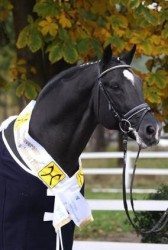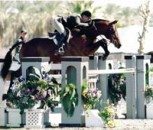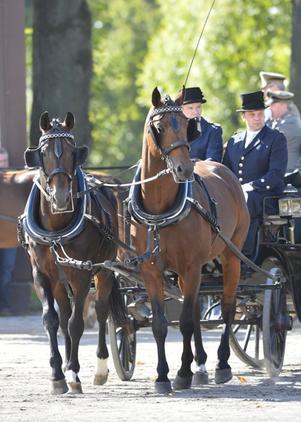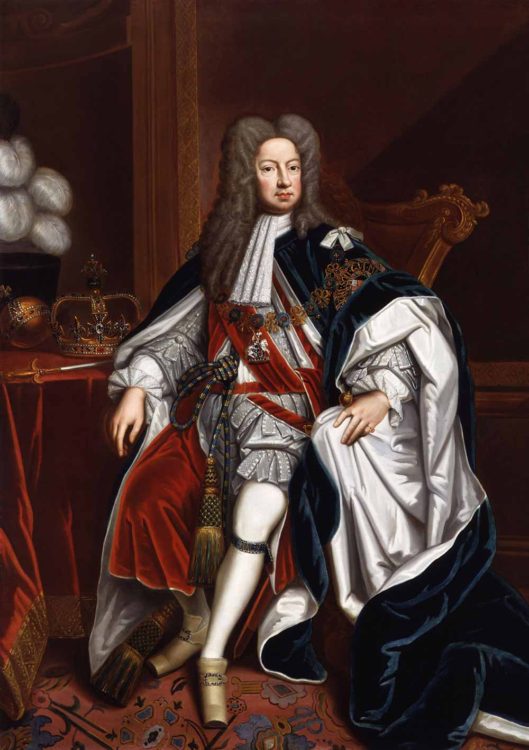 Hanoverian horses originated in the northwestern region of Germany known as Hanover (part of the German state of Lower Saxony), where horse-breeding as an industry had flourished for centuries. Even the flag and the coat-of-arms for Lower Saxony features a Hanoverian horse.
Hanoverian horses originated in the northwestern region of Germany known as Hanover (part of the German state of Lower Saxony), where horse-breeding as an industry had flourished for centuries. Even the flag and the coat-of-arms for Lower Saxony features a Hanoverian horse.
Hanoverians rank amongst the oldest, most numerous, and even the most successful of the warmbloods. The term warmblood distinguishes the Hanoverian horse as a middle-weight — thus differentiating it from “cold bloods” (e.g. draft horses) and “hot bloods” (e.g. Thoroughbreds and Arabians).
Noted for their sturdiness and stamina, warmblood Hanoverians were originally employed in the military as warhorses for the cavalry. Of course, Hanoverians were likewise bred as carriage horses because of their reliable robustness and their elegance, both of which reflected well on the status of their owners. The tradition of utilizing cream Hanoverians as coach horses, for instance, was prevalent amongst the British aristocracy, especially during the Georgian Era (the time period when Britain was ruled by George I, George II, George III, and George IV — from 1714 on through to 1830 — until the switch was made to Windsor Greys).

The bloodline of Hanoverians is said to reach as far back as the early Middle Ages. Then the infusion of Thoroughbred genetics into their bloodline opened a new era for Hanoverian horses — allowing them to be more agile and thereby well-suited for competition. Since World War II there have also been occasions when Trakehners were crossed with Hanoverians to refine the stock for husbandry purposes.
 Hanoverians are renowned for their noble grace, athleticism, trainability, friendly temperament, versatile performance, and beauty — which naturally makes them a popular choice in equine events. They have a light, elastic gait that gives them what many experts in the Hanoverian society describe as “a ground-covering walk, a floating trot, and a soft, round, rhythmic canter.” Indeed, Hanoverians are deemed the most prominent breed of riding horses, often winning Olympic and World Championship competitions across the board in dressage, show jumping, and three-day eventing. Interestingly enough, many of the top competitive Hanoverian horses sport on their left hindquarter the distinguishing H brand, or Hanoverian trademark if you will, that appears as “crossed horse heads at the gable of the breeding farms in Lower Saxony.”
Hanoverians are renowned for their noble grace, athleticism, trainability, friendly temperament, versatile performance, and beauty — which naturally makes them a popular choice in equine events. They have a light, elastic gait that gives them what many experts in the Hanoverian society describe as “a ground-covering walk, a floating trot, and a soft, round, rhythmic canter.” Indeed, Hanoverians are deemed the most prominent breed of riding horses, often winning Olympic and World Championship competitions across the board in dressage, show jumping, and three-day eventing. Interestingly enough, many of the top competitive Hanoverian horses sport on their left hindquarter the distinguishing H brand, or Hanoverian trademark if you will, that appears as “crossed horse heads at the gable of the breeding farms in Lower Saxony.”
Regulations prevent the registry of horses with too much white, palomino, cremello, or buckskin. Consequently, Hanoverian horses are often found in grey, black, brown, bay, and chestnut coat colors.
Photo Credits: Photos on the Gallery — (1) Photo of Benetton Dream is by Ken Braddick; (2) Photo of Hanoverian horse in competition mid-jump is from Learn-About-Horses.com; (3) Trotting Horse is from LandgestuetCelle.de; (4) Lower Saxony Flag is from LandgestuetCelle.de. Photos accompanying the Article page — (1) Logo for the American Hanoverian Society is from Hanoverian.org; (2) Hanoverian horse is from LandgestuetCelle.de; (3) Ragtime Indio in competition midjump is from ChinaBlueFarm.com. Featured image of the carriage Hanoverian horses is from LandgestuetCelle.de.

